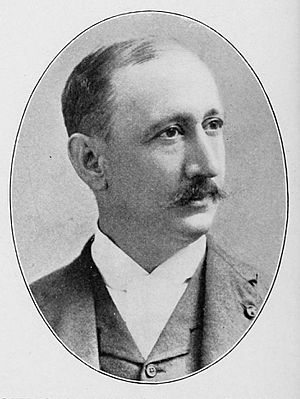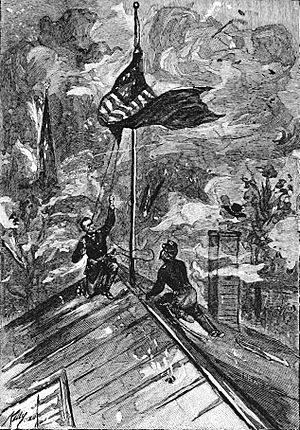Johnston de Peyster facts for kids
Quick facts for kids
Col. Johnston de Peyster
|
|
|---|---|
 |
|
| Mayor of Tivoli-on-Hudson | |
| In office January 1, 1900 – May 27, 1903 |
|
| Member of the New York State Assembly for Dutchess Co. | |
| In office January 1, 1889 – December 31, 1890 |
|
| Preceded by | John I. Platt |
| Succeeded by | Edward B. Osborne |
| Personal details | |
| Born |
Johnston Livingston de Peyster
June 14, 1846 Tivoli, New York |
| Died | May 27, 1903 (aged 56) Tivoli, New York |
| Political party | Republican |
| Spouse | Julia Anna Toler |
| Relations | John de Peyster Jr. (brother) Frederic de Peyster (grandfather) |
| Children | 3 |
| Parents | John Watts de Peyster Estelle Livingston |
| Signature | |
Johnston Livingston de Peyster (born June 14, 1846 – died May 27, 1903) was an American soldier and politician. He served in the Union Army during the American Civil War. Later, he became a member of the New York State Assembly and even the Mayor of his hometown.
Johnston de Peyster came from a rich and well-known family in Dutchess County, New York. He joined the Union Army when he was eighteen years old. He is famous for being the first to raise the Union flag over the Confederate capital in Richmond, Virginia, after it was captured in 1865.
After the war, de Peyster worked as a diplomat in other countries. When he came back to the United States, he entered politics. He was elected to the State Assembly. He had some disagreements with his father, who was also a very influential person. Their disagreements even led to them running against each other for Mayor! Johnston won, and because his father owned the town hall, the Mayor's office had to move. He passed away in 1903.
Contents
Early Life and Family Background
Johnston de Peyster was born on June 14, 1846, in Tivoli, New York. His family lived on a large estate there. He was part of the very wealthy and important de Peyster family from New York.
His father was Major General John Watts de Peyster, and his mother was Estelle Livingston. Johnston also had a brother, Brigadier General John Watts de Peyster Jr.. His family had a long history in New York. For example, his great-great-great-grandfather, Abraham de Peyster, was an early Mayor of New York City.
Military Career During the Civil War
When the Civil War began in 1861, Johnston was only fifteen years old. He was studying at Highland Military College in Newburgh, New York. He wanted to join the army right away. He even tried to raise a group of soldiers for a New York regiment.
Johnston's father offered money to men who joined his son's company. However, Johnston was too young to lead soldiers himself. His family also thought he was too young to serve in the war. But Johnston was determined. In 1863, he threatened to go to Washington, D.C., to try and become an officer in a colored regiment.
Joining the Union Army
Finally, in 1864, when he was eighteen, his family allowed him to join the Union Army. He became a second lieutenant. He was assigned to the 13th New York Heavy Artillery Regiment. This unit was part of the XVIII Corps in the Army of the James.
His unit was involved in the Bermuda Hundred campaign. Johnston got sick with a fever while stationed in Norfolk, Virginia. He had to go home for six months to recover. Because of this, he missed some of the biggest battles his unit fought, like the siege of Petersburg. The illness he caught would affect his health for many years.
Raising the Flag in Richmond

When Johnston returned to duty, he joined the staff of Brigadier General George Foster Shepley. General Shepley later became Chief of Staff for the XXV Corps, and Johnston became an aide to its commander, Major General Godfrey Weitzel. Johnston eventually became Weitzel's chief of staff.
Johnston de Peyster is famous for raising the first official Union flag over the Confederate capital of Richmond, Virginia, on April 3, 1865. This happened after the city fell to Union forces. The flag he raised was the same one that had been flown over New Orleans, Louisiana, after it was captured earlier in the war.
Initially, Johnston was chosen to lead an attack on the city's defenses. However, the night before the attack, he saw that the city was on fire from a signal tower. He quickly told General Weitzel. Because of this, the Union soldiers were able to enter the city without a fight. Admiral David Farragut later said that Johnston deserved as much credit as if he had stormed the city, because he achieved the goal without bloodshed.
There was a small argument about who raised the "first" flag. Another officer had raised a smaller flag (a "guidon") a couple of hours before Johnston raised the large national flag. But Ulysses S. Grant, the Union's top general, decided that Johnston should get the credit because a guidon wasn't considered a "real" flag.
For his actions, Johnston was promoted to lieutenant colonel. This promotion recognized his "gallant and meritorious conduct" and for raising the first true American flag over Richmond. Soon after, he received another promotion to colonel. He left the army in June 1865.
Life After the War
After the Civil War, Johnston de Peyster returned to Tivoli, New York. He became involved in several important groups, including the American Archaeological Association and the New York Yacht Club. He also joined military and historical societies.
He served as an assistant to Daniel Sickles, a former general who became a diplomat in Spain.
Political Career and Public Service
Johnston de Peyster was elected to the New York State Assembly for Dutchess County in 1889 and served two terms. Later, he became the Mayor of his hometown, Tivoli-on-Hudson, for several terms. He also served as President of the New York Society Library.
He was very active in helping others and gave many donations to libraries and historical societies. This is known as philanthropy.
A Family Disagreement
Johnston shared some interests with his father, like helping others and military history. However, they had a big disagreement when Johnston was in the State Assembly. His father strongly opposed one of his votes on a bill for the 1889 World's Fair.
Their disagreement became very serious. When Johnston was Mayor of Tivoli, his father, who owned the building where the town government met, would not let his son enter. This forced the village government to move its offices to another building. They stayed there until 1894, when they finally moved back. The disagreement was so strong that Johnston's father even ran against him for Mayor of Tivoli in 1900. But Johnston won the election!
Family Life
Johnston de Peyster was married to Julia Anna "Annie" Toler. They had three daughters:
- Estelle de Peyster (1872–1953)
- Mary Justine de Peyster (1875–1939)
- Carola de Peyster (1882–1950), who became a writer for Harper's Bazaar.
Johnston de Peyster passed away in 1903. He died before his father, and all of his brothers and sisters also passed away before their father.

